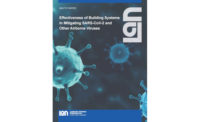Research has shown that transmission of SARS-CoV-2 most often occurs through the air via respiratory droplets sized greater than 5-10 microns in diameter. This transmission occurs when a person comes into close contact within three to six feet of an infected individual who releases respiratory droplets into the air by coughing, sneezing, talking, shouting, singing, laughing, etc. These respiratory droplets can contain the virus and may result in infection if they reach the mouth, nose, or eyes of a susceptible person. The reason why transmission in this manner occurs within close contact situations is that these larger droplets mostly fall out of the air within three to six feet. It is also suspected that direct contact with an infected person’s saliva, for example through kissing, can transmit the virus from person to person.
The second mode of SARS-CoV-2 transmission can occur when respiratory droplets from infected individuals land on and contaminate objects and other surfaces.
These contaminated surfaces are referred to as fomites. Studies have concluded that this virus can remain viable on surfaces for periods ranging from hours to days depending on the type of surface and environmental factors such as temperature and humidity levels. Fomite transmission of SARS-CoV-2 may occur when a susceptible person touches objects or surfaces contaminated with virus and then touches his/her mouth, nose, or eyes, or those of another person.
This white paper is intended to provide guidance for owners of commercial buildings, including K-12 schools, higher education campuses, and office buildings, to consider while returning to occupancy during the COVID-19 pandemic.





